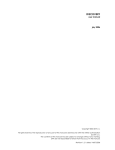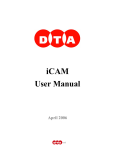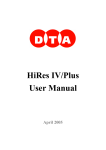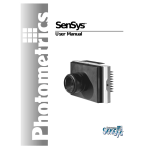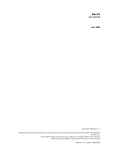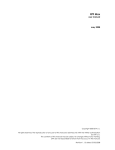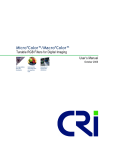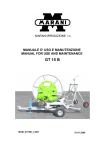Download User Manual (PDF, July 2006)
Transcript
CHROMA user manual july 2006 Copyright 2006 DTA s.r.l. All rights reserved. The reproduction of any part of this manual is allowed only with the written authorization by DTA s.r.l.. The contents of this manual may be subject to changes without any warning. DTA are not responsible for errors that may occur in this manual. Revision 1.4.2 dated 31/07/2006 Copyright 2006 DTA s.r.l. All rights reserved. The reproduction of any part of this manual is allowed only with the written authorization by DTA s.r.l.. The contents of this manual may be subject to changes without any warning. DTA are not responsible for errors that may occur in this manual. Revision 1.4.2 dated 31/07/2006 CHROMA user manual CONTENTS introduction …… 3 personal computer minimum requirements …… 4 personal computer recommended requirements …… 4 scheme of the installation procedure …… 5 connecting the FDL interface card to the PC …… 6 library & fdl-pci installation windows xp …… 7 software installation procedure ….. 10 linux …… 11 windriver registration …… 13 connecting cables and power leads detail of the chroma’s lower panel connectors …… 16 44-pin parallel port connector …… 17 26-pin user port connector …… 18 power supply connector …… 18 configuration of chroma in the array mode …… 19 mounting or replacing filters …… 20 optical window cleaning …… 22 specifications …… 23 index …… 25 ©2006 dta s.r.l. p. 1 CHROMA user manual p. 2 ©2006 dta s.r.l. CHROMA user manual INTRODUCTION CHROMA is a cooled CCD camera series we produce professionally ourselves that is capable of offering high performances. The series is characterized by high sensitivity, fast image downloading, reduced weight and dimensions. This includes the cameras: CHROMA CX 3, CHROMA CX 3 Small and CHROMA C3 Plus. All this kinds use Kodak KAF CCD sensors, displaying a wide range of resolutions and pixels dimensions. The sensors are front-illuminated, supported by an excellent Quantum Efficiency, with possible antiblooming or enhanced options (ITO). All of them (apart to those with the antiblooming option) can offer a 100% fill factor, allowing one to shoot marvellous images. The camera is connected to the PC by a FDL-PCI interface card and powered at 13.8 V, but it can also be used in the open air using a car battery. Optionally, a filter wheel with 6 or 8 positions may also be internally integrated for CX3 and C3 Plus series, or as an alternative, fast VariSpec interferential LCD filters, electronically run. Among the main application fields: Biology, Astronomy, Plasma Physics, Semiconductor Physics. CX3 As it is characterised by high integration it offers quality performances: fast downloading of image (up to 2.2 Mpixel/s) and a high dynamic range, thanks to a 14 bit A/D Converter with programmable CDS at 64 amplification gains. The latter characteristic enables us to better optimise the binning function modalities. It performs -40°C below ambient thanks to a Single stage Peltier cooling system. Every component is integrated in the aluminium head: CCD, electromechanical shutter, Peltier cooling system, electronics, a motorized filter wheel (optional). The camera is connected to the PC by means of a parallel port (alternatively, a fiber optic connection can be made). CX3 Small It is the compact version of the CX3, that is the dimensions have been reduced to: 140x110x95 mm. All the technical specs are the same of CX3 but the possibility to mount an internal filter wheel. C3 Plus The CHROMA C3 plus is an upgrade for the CHROMA CX 3: it has a better resolution due to 16 bit A/D Converter, a readout speed ≥ 1Mpixel/s and, more, it is equipped of three integrated peripherals: 1) two 32-bit generators able to yield impulses starting from 100 ns with internal time base, or from 20 ns with external time base; 2) a 32-bit time delay with a 100 ns step with an internal time base or 20 ns with external time base; by means of these three devices, you can run an MCP, a LASER or other external devices, as well as synchronize them to the image acquisition. ©2006 dta s.r.l. p. 3 CHROMA user manual PERSONAL COMPUTER MINIMUM REQUIREMENTS • CPU Pentium III 500 mHz . • 256 Mb of RAM. • Microsoft Windows 98. • Hard Disk with at least 200 Mb available. PERSONAL COMPUTER RECOMMENDED REQUIREMENTS • CPU Pentium IV 2 GHz or higher. • 512 Mb RAM. • Colour monitor 19”. p. 4 ©2006 dta s.r.l. CHROMA user manual SCHEME OF THE INSTALLATION PROCEDURE When you use the camera for the first time, you must install the library and the FDL-PCI interface. For this purpose, please follow the procedure described in the next pages and schematized in the diagram below: Turn off the PC Insert the FDL-PCI card interface in the proper slot LINUX WINDOWS Turn on the PC Let install the DRIVER WINDOWS OS ask to you the DRIVER: specify the directory within the provided CD Let install ViSTA software Verify the configuration of the camera with CAMERA SELECT option ©2006 dta s.r.l. p. 5 CHROMA user manual CONNECTING THE FDL INTERFACE CARD TO THE PC To install your FDL interface card, do as follow : ⇒ Turn your PC off, including any peripheral. ⇒ Remove the external case of the PC (please see the relevant instructions in the PC Handbook). ⇒ Choose a free PCI expansion slot. Remove the relevant back cover by means of a screwdriver. ⇒ Insert the camera interface card into the expansion slot. Please make sure that the card is properly and fast inserted. Fix the card by screwing the relevant screw again. ⇒ Reassemble the PC case. Turn the PC on once again. The interface card installation has been completed. In case of a fiber optic link connection, a dedicated FDL-PCI is provided with the proper connectors. p. 6 ©2006 dta s.r.l. CHROMA user manual LIBRARY & FDL-PCI INSTALLATION The installation of the library is always linked to the installation of the camera, of course. For this purpose you just need to install the PCI interface as well. Let’s analyse the sequence of operations to be carried out. It will be shown the example with WINDOWS XP Operating System. The operations are similar for the other Operating Systems. Once you turn the system on for the first time with the FDL-PCI interface on, you will be asked to specify where the available drivers are. Follow the steps on the basis of your Operative System. WINDOWS XP Insert the FDL-PCI card into the slot of the motherboard and turn the PC on. As soon as the system gets started, a window (like the one shown below) will appear, noticing you a new hardware was found. You’ll be requested to connect for Windows update, let select: “No, not at this time”. ©2006 dta s.r.l. p. 7 CHROMA user manual Insert the "ViSTA" CD into the CD-ROM reader, close the "Quick Install" (it may open due to the CD autorun). Select the option "Install from a list or specific location (Advanced)” (recommended choice). Then click on "Next" to continue the installation. Check the function selected in the window (recommended choice) below (in this case, E:\ indicates the CD-ROM drive) and click on next to continue. The PC will start to search for the most suitable driver to the peripheral. p. 8 ©2006 dta s.r.l. CHROMA user manual Select the folder that contains drivers for FDL-PCI hardware and click on OK. Then, wait while the wizard installs the software (just few seconds). When the installation has been completed, a window like the one below will appear. Click on finish to close the wizard and restart the PC (recommended choice). ©2006 dta s.r.l. p. 9 CHROMA user manual SOFTWARE INSTALLATION PROCEDURE: When you use the camera for the first time, you must install the ViSTA software. Insert the ViSTA 3 CD-ROM, provided with the camera, into the CD-ROM reader, wait a few seconds so as to allow the PC to load the "QUICK INSTALL" menu. Let click on ViSTA 3 and QUICK INSTALL will start and take you through the process of installing the software. The default settings will install the full software package and all options. You may be asked to reboot the PC if certain files in use by Windows needs to be updated. p. 10 ©2006 dta s.r.l. CHROMA user manual LINUX System Requirements • • • Linux 2.0.31 or higher (can be embedded Linux or Linux 2.4x) An x86 processor. Any 32-bit development environment supporting C (such as GCC). Preparing the system for installation In Linux, kernel modules must be compiled with the same header files that the kernel itself was compiled with. Since WinDriver installs the kernel module windrvr6.o, it must compile with the header files of the Linux kernel during the installation process. Therefore, before you install WinDriver for Linux, verify that the Linux source code and the file versions.h are installed on your machine: Install linux kernel source code • • If you have yet to install Linux, please choose Custom installation when performing the installation and then choose to install the source code. If Linux is already installed on the machine, you must check to see if the Linux source code was installed. You can do this by looking for linux in the /usr/src directory. If the source code is not installed, you can either reinstall Linux with the source code, as described above, or you can install the source code by following these steps: 1. Login as super user. 2. Type: /$ rpm -i /<source location>/ <Linux distributor>/RPMS/kernel-source-<version number> (For example: to install the source code from the Linux installation CD-ROM, for RedHat 7.1, type: /$ rpm -i /mnt/cdrom/RedHat/RPMS/ kernel-source-2.4.2.-2.i386rpm) TIP! If you do not have an RPM with the source code, you may download it from: http://rpmfind.net/linux/RPM/. Install version.h • The file version.h is created when you first compile the Linux kernel source code. Some distributions provide a compiled kernel without the file version.h. Look under /usr/src/linux/include/linux/ to see if you have this file. If you do not, please follow these steps: 1. Type: /$ make xconfig 2. Save the configuration by choosing Save and Exit. 3. Type: /$ make dep. Before proceeding with the installation, you must also make sure that you have a linux symbolic link. If you do not, please create one by typing: /usr/src$ ln -s <target kernel>/ linux (For example: for Linux 2.4 kernel type: /usr/src$ ln -s linux-2.4/ linux) ©2006 dta s.r.l. p. 11 CHROMA user manual Installation 1. 2. 3. 4. Insert the DTA SDK CD into your Linux machine CD drive or copy the downloaded file to your preferred directory. Change directory to your preferred installation directory (your home directory, for example): /$ cd ~ Extract the file WDxxxLN.tgz (where xxx is the version number): ~$ tar xvzf /<file location>/WDxxxLN.tgz For example: o From a CD: ~$ tar xvzf /mnt/cdrom/LINUX/WDxxxLN.tgz o From a downloaded file: ~$ tar xvzf /home/username/WDxxxLN.tgz Change directory to WinDriver (this directory gets created by tar): ~$ cd WinDriver/ NOTE: From version 5.x and above this directory gets created by tar, but in versions preceding 5.x the WinDriver directory does not get created by the extraction. Therefore, when working with versions preceding 5.x (version 4.33, for example) first create a directory (e.g., WinDriver) before proceeding with the installation. (/$ mkdir ~/WinDriver) 5. 6. 7. 8. 9. Install WinDriver: a. ~/WinDriver$ make b. Become super user: ~/WinDriver$ su c. Install the driver: ~/WinDriver# make install Create a symbolic link so that you can easily launch the DriverWizard GUI ~/WinDriver$ ln -s ~/WinDriver/wizard/wdwizard/ usr/bin/wdwizard Change the read and execute permissions on the file wdwizard so that ordinary users can access this program. Change the user and group ids and give read/write permissions to the device file /dev/windrvr6 depending on how you wish to allow users to access hardware through the device. You can now start using WinDriver to access your hardware and generate your driver code! Restricting Hardware Access on Linux CAUTION: Since /dev/windrvr6 gives direct hardware access to user programs, it may compromise kernel stability on multi-user Linux systems. Please restrict access to the DriverWizard and the device file /dev/windrvr6 to trusted users. For security reasons the WinDriver installation script does not automatically perform the steps of changing the permissions on /dev/windrvr6 and the DriverWizard executable (wdwizard). p. 12 ©2006 dta s.r.l. CHROMA user manual WINDRIVER REGISTRATION After the installation of the drivers for the FDL-PCI card, we need to record the files to make them work properly. Insert the "ViSTA 3" CD into the CD-ROM reader, wait a few seconds so as to allow the PC to load the "QUICK INSTALL" menu. Once the PC has loaded the "QUICK INSTALL" menu, follow the steps below: Register the drivers according to your Operating System, clicking on the proper Drivers Registration field: FDL-PCI on XP/2000 (for WINDOWS XP/2000) FDL-PCI on 98/Me (for WINDOWS 98/Me) Install ViSTA 3 just clicking on the proper field ©2006 dta s.r.l. p. 13 CHROMA user manual Once you have installed the drivers and the "ViSTA 3" software, restart the PC. When you restart the PC, it is suggested to check the correct installation of the peripheral, that is if the installation of the necessary drivers for the FDL-PCI card and WINDRIVER has been carried out good. According to the different Operating Systems, you have to click on "System Properties" by means of the right key of the mouse. The images below refer to the case you use Windows XP as OS. A menu with different options will open; click on "Hardware" by means of the left key of the mouse and on "Device Manager". Then check if the FDL-PCI peripheral has been installed correctly (see the images sideways). p. 14 ©2006 dta s.r.l. CHROMA user manual The tests have been carried out with the following OS’s: WINDOWS 98 SECOND EDITION WINDOWS 2000 WITHOUT SERVICE PACK WINDOWS 2000 WITH SERVICE PACK 3/4/5 WINDOWS ME WINDOWS XP WITHOUT SERVICE PACK WINDOWS XP WITH SERVICE PACK 1/2 ©2006 dta s.r.l. p. 15 CHROMA user manual CONNECTING CABLES AND POWER LEADS Now it is possible to connect the cables betweeen the free interface and the camera. We advise you to carry out this operation with all your instruments not powered. The connectors are fixed by means of screws; these, however, should only be slightly tightened to avoid any damage to them. For the C3 series the power connector is connected to the PWR series power supply. The camera is turned on at the power supply. Screws DETAIL OF THE CHROMA’S LOWER PANEL CONNECTORS On the bottom side of CHROMA you will find the connectors required to connect it to the PC, to the power supply and to mount it on to a photographic tripod. Starting from the top left the following connectors are shown: • • • Power connector. USER PORT : 26-pin connector which implements an 8-bit parallel communication, that is bidirectional and programmable. PARALLEL PORT : 44-pin high-density connector for 8/16/32 bit parallel communication by means of a given FDL-PCI card. p. 16 ©2006 dta s.r.l. CHROMA user manual 44 PIN PARALLEL PORT CONNECTOR 1 6 11 16 21 26 31 36 41 • • • • • • • • • D0 D15 D18 D1 VCC D19 D2 VCC D20 2 7 12 17 22 27 32 37 42 D3 ACK D21 D4 REQ D22 D5 A/D D23 3 8 13 18 23 28 33 38 43 D6 R/W D24 D7 STB D25 D8 GND D26 4 9 14 19 24 29 34 39 44 D9 GND D27 D10 GND D28 D11 GND D29 5 10 15 20 25 30 35 40 - D12 GND D30 D13 D16 D31 D14 D17 - D[16:31]: used in special applications . D[0:15]: data. REQ: by means of this pin the CHROMA proceeds to request transfer to the PC. ACK: reply signal to REQ coming from PC. A/D: presence of addresses or data on the bus is indicated by means of this pin. R/W: indicates whether the operation th carry out is a reading or writing one. STB: STROBE signal. GND: ground. VCC: +5V. Note: all signals are TTLcompatible. By means of this port it is possible to carry out a connection between the CCD camera and the PC by means of a FDL card. When the FDL interface card is the PCI kind (model FDL-PCI) a maximum transfer speed of 1.5 Mpixel/s is possible with a maximum distance between the PC and the camera of 2.5 m ; when the interface is the ISA kind (model FDL-ISA) the transfer rate is 250 kpixel/s with a maximum distance of 5 m. ©2006 dta s.r.l. p. 17 CHROMA user manual 26 PIN USER PORT CONNECTOR 1 4 7 10 13 16 19 22 25 • • • • • • • • • +5V PA6 PB7 SEL2 PA7 TRG BUSEL PB0 ESHUT 2 5 8 11 14 17 20 23 26 PA0 PB1 SHUTTER PA1 PB2 TACK PA2 PB3 SEL0 3 6 9 12 15 18 21 24 - PA3 PB4 SEL1 PA4 PB5 GND PA5 PB6 - PA[0:7]: bidirectional parallel port reserved for user. PB[0:7]: bidirectional parallel port reserved for user BUSEL: establishes the parallel bus dimension, 0 = 8bit, 1 = 16/32 bit SHUTTER: TTL exit of the shutter, used for the control of a second external shutter. ESHUT: by means of this signal, the user can directly control the shutter (by keeping it at 1 the shutter stays open, otherwise it will close). SEL[0:2]: establishes the address, as peripheral, of the Chroma in the 0-7 range. TRG: bidirectional pin for the transmission of trigger signals from and to the camera. TACK: input from the camera that this has seen an input trigger signal. GND: ground. NOTE: All signals are TTL compatible. POWER SUPPLY CONNECTOR POWER SHUTTER POSITIVE + NEGATIVE - Front view By means of this connector 12V 5A power is carried to the CHROMA. p. 18 ©2006 dta s.r.l. CHROMA user manual CONFIGURATION OF CHROMA IN THE ARRAY MODE The CHROMA series enables you to simultaneously manage as many as sixteen devices using a single FDL-PCI interface at the same time. What is guaranteed is that the sixteen cameras take the shot at the same instant and these are downloaded in sequence. To use this mode you need a special cable which connects the cameras up together and subsequently programme the number of identities of each camera by means of the internal dip switch. Here we show the layout of the switches for the various addresses: 4 ON ON ON ON ON ON ON ON OFF OFF OFF OFF OFF OFF OFF OFF 3 ON ON ON ON OFF OFF OFF OFF ON ON ON ON OFF OFF OFF OFF 2 ON ON OFF OFF ON ON OFF OFF ON ON OFF OFF ON ON OFF OFF 1 ON OFF ON OFF ON OFF ON OFF ON OFF ON OFF ON OFF ON OFF Address 0 1 2 3 4 5 6 7 8 9 10 11 12 13 14 15 After mounting the programme keys, ViSTA must be informed of the cameras and addresses present. To carry out this operation select from the menu FILE CAMERA ARRAY SETUP: The START CAMERA ARRAY command will enable you to use the cameras simultaneously. ©2006 dta s.r.l. p. 19 CHROMA user manual MOUNTING OR REPLACING FILTERS CHROMA optionally manages a set of 6 or 8 filters with 25mm diameter with 5mm maximum thickness. In addition to the filters on the wheel, a ninth one can be directly mounted on the external adapter, dedicated generally to blocking infrared emission. The following diagram outlines the course the light follows before reaching the sensor. Selectable Filter CCD Optical axis Infrared stop Shutter Photographic adapter Filterwheel Front pannel To acquire access to any one of the internal filters the first thing you need to do is remove the photographic adapter. After removing the adapter, you take out, if present, the infrared stop and after clutching on to the perforation you see you must pull the plug off using an upwards movement. At this point should have access to the internal filters. p. 20 ©2006 dta s.r.l. O-Ring Adapter Infrared stop CHROMA user manual If you need to remove a filter, a small screwdriver should be used paying attention not to damage the filter itself. On the other hand, when you need to mount a new filter in the wheel the three clamping screws must be removed, the filter can then be placed in its proper site, after which the screws will again be tightened with the oring. To carry out this operation we strongly recommend the use of “stamp” tweezers with a hooked end, holding the screw in the tweezers with one hand and the screwdriver with the other hand. We advise you to fit the screw loosely to avoid deforming the O-Ring. We also suggest this should take place on a clean and well-lit table wearing, if possible, fine lattice gloves or something similar to avoid leaving fingerprints on the mechanical or optical parts of the camera. When you need to dust the filters we advise the use of filtered compressed air especially designed for the cleaning and maintenance of cameras; alternatively you might use a special photographer’s brush. If there happen to be fingerprints or stains, use Kodak lens cleaning paper. Lattice gloves Cleaning filters with photographer’s brush ©2006 dta s.r.l. p. 21 CHROMA user manual OPTICAL WINDOW CLEANING Both the optical window and the CCD cleaning are carried out in the clean room by means of a 30-magnifying power microscope. This procedure removes any dust which can otherwise bring about unmistakable marks on the image you have taken. In particular such spots increase as the focal ratio gets wider. In other words an image may not show any mark at f/5.6 but it can be clearly noted at f/32 because of an obvious geometrical problem of projection. Due to the shutter or elapsed time, the external surface of the optical window may gather dirty particles that may be easily removed. To perform such task we use a compressed air cylinder specifically designed for optical cleaning. Be careful !!! There are similar products that, instead of using compressed air, use a liquefiable gas : at ambient pressure it quickly gassifies, thus “triggering” an air-compressed-effect. You do not absolutely have to use these products : they may give rise to heavy marks or rings on the windows itself. A product we can recommend is DUST-OFF provided by EDMUND-OPTICS. Thanks to DUST-OFF (or any other similar product) it is very easy to get rid of any microparticles : keep the shutter open for a few seconds (by the camera control program) and spray some air blast. We kindly advise you against using cloths, optical paper and cleaning liquids because the dirt will be only mixed up or, even worse, increased. The risk is to finally damage the coating of the optical window itself ! p. 22 ©2006 dta s.r.l. CHROMA user manual SPECIFICATIONS SHUTTER: Electromechanical. Exposure time: from 0.01 s to 9999 s A/D CONVERTER: 14 bit for CX3/CXS Selectable: 12, 14, 16 bit for C3P SETTABLE GAINS: 64 READ OUT SPEED: Up to 2.2 Mpix/s for CX3/CXS250 ≥ 1 Mpix/s for C3P INTERFACE: FDL-PCI 8, 16, 32 bit COOLING: Single stage PELTIER (-40 °C ∆T below ambient) OPTICAL WINDOW: • BK7 with double AR • Quartz • Sapphire FILTER MANAGEMENT (opt.): • Filterwheel: 6/8 positions, 25mm diameter • LCD RGB VariSpec BACKFOCUS: 26.8/17.5 mm MAX TOTAL NOISE: 10 eMOUNT: 42x0.75 or C BINNING: From 1 x 1 to 8 x 8 or arbitrary ©2006 dta s.r.l. p. 23 CHROMA user manual POWER SUPPLY: 230 V MAX ABSORPTION: 42 W WEIGHT: 1.6 Kg (filterwheel included) DIMENSIONS: 155 x 134 x 62 mm3 for CX3/C3P 140x110x95 mm3 for CXS p. 24 ©2006 dta s.r.l. CHROMA user manual INDEX 26 26-pin user port connector …… 18 44 44-pin parallel port connector …… 17 c connecting cables and power leads …… 16 connecting the fdl interface card to the pc …… 6 configuration of the chroma in array mode …… 19 d detail of the chroma's lower panel connectors …… 16 i introduction …… 3 l library & fdl-pci installation …… 7 linux …… 11 m mounting or replacing filters …… 20 o optical window cleaning …… 22 p personal computer minimum requirements …… 4 personal computer recommended requirements …… 4 power supply connector …… 18 s scheme of the installation procedure …… 5 software installation procedure …… 10 specifications …… 23 w windows xp…… 7 windriver registration …… 13 ©2006 dta s.r.l. p. 25 CHROMA user manual dta s.r.l. viale campania 23, 56021cascina (pisa) - italy, web site: www.dta.it , e-mail: [email protected] p. 26 ©2006




























